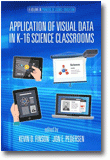
Application of Visual Data in K-16 Science Classrooms
Edited by:
Kevin D. Finson, Bradley University
Jon Pedersen, University of South Carolina
Published 2015
This book examines visual data use with students (PK-16) as well as in pre-service in- service science teacher preparation. Each chapter includes discussion about the current state of the art with respect to science classroom application and utilization of the particular visual data targeted by the author(s), discussion and explanation about the targeted visual data as applied by the author in his/her classroom, use of visual data as a diagnostic tool, its use as an assessment tool, and discussion of implications for science teaching and/or science teacher preparation.
Although the body of research and practice in this field is growing, there remains a gap in the literature about clearly explicating the use of visual data in the science classroom. A growing body of literature discusses what visual data are (although this topic is still viewed as being at the beginning of its development in educators’ thinking), and there are some scattered examples of studies exploring the use of visual data in science classrooms, although those studies have not necessarily clearly identified their foci as visual data, per se. As interest and attention has become more focused on visual data, a logical progression of questioning has been how visual data are actually applied in the science classroom, whether it be early elementary, college, or somewhere in between. Visual data applications of interest to the science education community include how it is identified, how it can be used with students and how students can generate it themselves, how it can be employed as a diagnostic tool in concept development, and how it can be utilized as an assessment tool. This book explores that, as well as a variety of pragmatic ways to help science educators more effectively utilize visual data and representations in their instruction.
CONTENTS
Foreword, Christine Tippett. Preface. SECTION I: PRE-K THROUGH ADULT. Planetarium-Based Science Visualizations to Support Complex Science Learning for First-Year Middle and High School English Learners, Thomas R. Tretter, Yuliya Ardasheva, Eric Bookstrom, Jameson Bowden, and Mark Duckwall. Dispositions of Scientists in Mainstream Films: The Extraordinary Person Called a Scientist, Ian C. Binns, Catherine M. Koehler, and Mark A. Bloom. Navigating Visual Data Literacy and Inscriptions in the Classroom, Kevin D. Finson, Joanne K. Olson, and Brandon Emig. SECTION II: ELEMENTARY (K–8). Utilizing Visual Data with Tablet Technology in the Primary (K–3) Science Classroom, Bridget T. Miller and Gerald H. Krockover. Using Visual Data in a Professional Development Program to Improve Science Teaching and Learning in K–6 Classrooms, Maria Lawrence and Li-Ling Yang. Teaching Children to Think Critically about Scientists: Examining the Relationship between Representations of Scientists, Process Skills and Visual Thinking Strategies (VTS), Donna Farland-Smith. Astronomy Seen in a New Light: Visualizations for Teaching Elementary and Middle School Students, Timothy Young and Mark Guy. SECTION III: HIGH SCHOOL. How High School Students Construct or Create Animations about Water Boiling, Jennifer L. Albert, Margaret R. Blanchard, and Eric N. Wiebe. Photographs as Static and Concrete Visual Representation to Connect Prior Knowledge and to Stimulate Discussions in Science Classrooms, Hyunju Lee and Allan Feldman. Understanding the Visual Data of Earth’s Ellipse and Axis Tilt, Catherine Lange, Joseph Zawicki, Douglas Anderson, and Kathleen Falconer. Using Web GIS to Promote Geospatial Thinking and Reasoning Skills, Alec M. Bodzin, David Anastasio, and Dork Sahagian. SECTION IV: COLLEGE LEVEL. Using Visual Data with Pre-Service Teachers: From Awareness to Application, Cindi Smith- Walters. Role of Visual Data in Effectively Teaching the Nature of Science, Michael P. Clough. Student-Centered Visualization in General Education Introductory Geoscience Classes, Giuseppina Kysar Mattietti and Erin E. Peters-Burton. Drawing Scientists Together: University Faculty’s Perceptions of Art and Perceived Barriers to Constructing and Implementing Visual Data in Science Classrooms, Renee M. Clary, John Paul Remo, Ryan Walker, and James H. Wandersee (deceased).
-
Paperback978-1-68123-047-4
Web price: $45.04 (Reg. 52.99)
-
Hardcover978-1-68123-048-1
Web price: $80.74 (Reg. 94.99)
- eBook978-1-68123-049-8

-
 (Re)Envisioning Social Studies Education Research
Current Epistemological and Methodological Expansions, Deconstructions, and Creations
(Re)Envisioning Social Studies Education Research
Current Epistemological and Methodological Expansions, Deconstructions, and Creations
-
 American Educational History Journal - Golden Anniversary Edition
Volume 50 Numbers 1 & 2
American Educational History Journal - Golden Anniversary Edition
Volume 50 Numbers 1 & 2
-
 Distance Learning
Volume 20 #3
Distance Learning
Volume 20 #3
-
 Distance Learning
Volume 20 #4
Distance Learning
Volume 20 #4
-
 Qualitative Research With Diverse and Underserved Communities
Qualitative Research With Diverse and Underserved Communities
-
 Quarterly Review of Distance Education
Volume 24 #1
Quarterly Review of Distance Education
Volume 24 #1
-
 Rekindling Embers of the Soul
An Examination of Spirituality Issues Relating to Teacher Education
Rekindling Embers of the Soul
An Examination of Spirituality Issues Relating to Teacher Education

